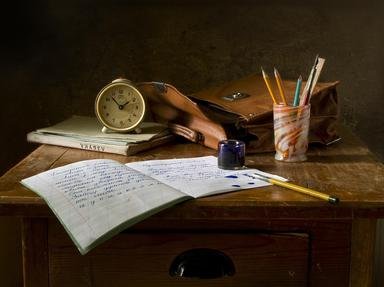Quiz Answer Key and Fun Facts
1. "And if Time is anything akin to ____, I suppose that Memory must be ____."
What are the missing words from the Prologue?
2. Jamie and Claire and a few other citizens of the Ridge are roused from their beds before dawn by a distraught Kenny Lindsay. Not far from Fraser's Ridge they come upon a partially-destroyed cabin; not one among its occupants remains alive.
What was the misfortune of the Dutchwoman and her children?
3. In Chapter 3 Claire and Major Macdonald are alerted to Young Ian's return by the appearance of an agitated Rollo on the path leading up to the Big House. Ian is rather the worse for wear, having received a concussion in an encounter with unknown assailants. Major Macdonald wants to believe Ian's attackers were Indians (Native Americans) but the Frasers don't think so.
What caused the injury to Ian's head?
4. Another head injury is sustained in Chapter 4, by Roger Mac: Brianna is disgruntled by the discovery of a raccoon in her pantry; while assessing the damage done, she is startled by the return of her husband and, thinking the invasive raccoon returned, turns and throws the object in her hand towards the door, hitting Roger squarely between the eyes.
What was the missile?
5. With respect to Fraser's high standing with the British government, Major Macdonald has come to ask Jamie if he will accept a village of Scottish emigrants onto his land who, because they speak almost no English, have not felt accepted elsewhere in the colony. The labour is welcome at Fraser's Ridge, which at this time has only twenty of its ten thousand acres under cultivation, but Jamie points out that these northern people are fisherfolk, not crofters (homesteaders), and doubts their chances of survival in the mountain wilderness the Frasers have chosen for their home.
"A man can learn to farm, surely?" remarks Major Macdonald, and hastens to suggest that farming likely cannot be more difficult than what?
6. Brianna and Roger Mac attend the engagement party for Fräulein Senga McGillivray and her lucky suitor. Brianna remarks that while she has met plenty of Hildas and Ingas (the names of the other two fräuleins McGillivray) in nearby Salem, she has yet to encounter another Senga. "It's Scots," reveals Roger: "Agnes" spelled backwards. Roger reminisces about his childhood where he attended school with a girl named Adnil, and about a grocer's boy in Inverness named Cire. Roger also reveals that he and his adoptive father, the Reverend Reginald Wakefield, used back-spellings of their own names in Roger's childhood to create names for Godzilla-esque monsters.
Regor was a beetle with death-ray eyes; what type of monster was Eigger?
7. A second purpose to Macdonald's visit to the Ridge is revealed: the Major would like to propose Jamie to the Southern Department of Indian Affairs as the Crown's liaison to the local tribes. Claire ponders the new title, "James Fraser, Indian Agent" and likens it to the names given to television Western heroes.
Ever befuddled by Claire's 20th-century similes, what is Jamie worried that he will be required to do?
8. The Frasers receive a messenger with a letter for Jamie, a gift of home-made wine and a package for Brianna from Lord John Grey. The letter details a very different version of an event in Massachusetts from that which is learned by schoolchildren in the modern era, and also serves as a letter of introduction for one of the victims, a scapegoated soldier whom Grey had taken into service at his Virginia plantation as his messenger after the soldier's disfiguration and dishonourable discharge from the army.
Is it true or false that Lord John Grey's new servant, a man named Bobby Higgins, is branded on his face with a "D" for "Dishonourable"?
9. Lizzie Wemyss takes frightfully ill from her malaria and is found in a crumpled heap on the hearth. Claire checks the cupboards in her surgery but she is out of the cinchona bark from which she had been giving Lizzie regular doses of quinine. Luckily Claire remembers a passage about gallberries and their uses in treating fevers in the late Dr. Rowling's medical journal. Like the cinchona bark, the gallberries have a very bitter taste, as Claire discovers when she bites into one.
What is mixed in the water that Jamie hands to Claire for her to drink?
10. Of Jamie Fraser's three sources for information about the future (Claire, Brianna and Roger Mac), Jamie least enjoys speaking with Roger. Claire's stories about her own time Jamie finds incredible and fantastic like fairy-tales, while Brianna tends to share with him items of entertainment (men walking on the moon) or details about machinery.
Conversations with historian Roger Mac, however, Jamie finds chilling, like his encounter with a fortune-teller in which city?
Source: Author
LadyCaitriona
This quiz was reviewed by FunTrivia editor
MotherGoose before going online.
Any errors found in FunTrivia content are routinely corrected through our feedback system.
